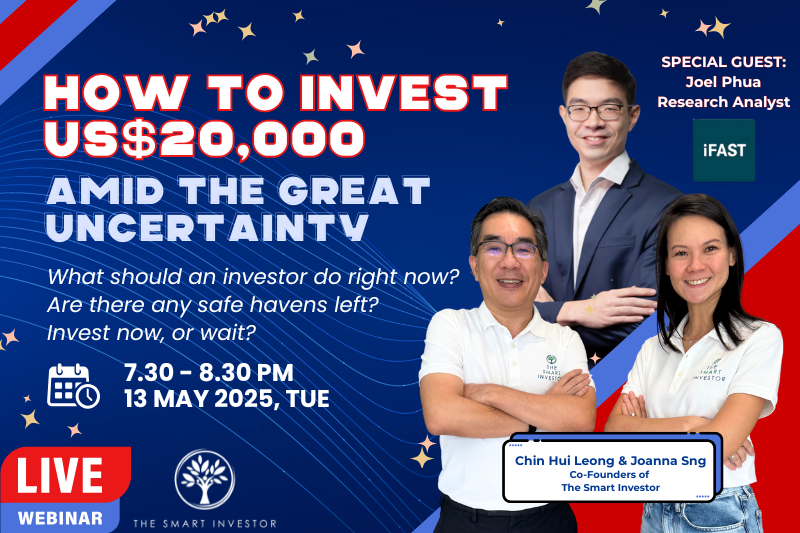If you have just started your investment journey, congratulations!
By allocating money to well-managed, high-quality stocks, you are on your way to enjoying a great long-term return as you compound your money.
There are other benefits to investing your money in stocks.
Many pay out a dividend when they report healthy profits and cash flows, thereby allowing you to enjoy a stream of passive income.
However, any activity which involves money will inevitably be an emotional one.
Investing is no different.
As you navigate the stock market, it is natural to feel a mixture of emotions as your hard-earned money is involved.
We highlight four important psychological red flags you need to be wary of if you want to become a successful investor.
1. Overconfidence
It may sound surprising, but many people feel far more confident than they should be when performing a range of different activities.
A US study found that 93% of drivers felt that their driving skills were better than average!
When investing, overconfidence can lead you to make avoidable mistakes as you let your guard down.
Feeling overconfident means you may gloss over the risks of an investment as you confidently push forward to park your money in a stock.
An overconfident investor also ends up trading more often as he or she thinks that this method helps to maximise profits.
Such frequent trading, however, only ends up incurring significant brokerage costs that erode your gains like sandpaper.
Overconfidence is so insidious that many investors do not even realise that they suffer from it.
A healthy way to mitigate the onset of overconfidence is to ensure you thoroughly review the rewards and risks related to any investment.
You can also do a sense check by asking a trusted and experienced investment buddy to validate your thesis and point out any flaws.
By doing so, you ensure that there are checks on your investment thought process to avoid glossing over important aspects that may impact your final decision.
2. Hindsight bias
Hindsight bias describes a situation where you believe you knew the outcome of an event before it occurred.
The problem with this bias is that it frequently crops up after major events such as pandemics and the Global Financial Crisis (GFC).
As such events are in the past and we know how they turned out, investors may believe that they could foresee or predict the eventual outcomes of these market-turning events.
It can be tough to convince your brain that you do not know how an event will proceed, thus leading to poor decision-making as you try to predict other events such as earnings or economic news.
A simple way to combat this bias is to maintain an investment journal.
By chronicling your thoughts on why you bought a stock and how you felt, you avoid hindsight bias as you check back on these facts.
3. Confirmation bias
Confirmation bias is another investment red flag that causes you to only seek out information that conforms to your views and beliefs.
This bias is pervasive and can lead to overconfidence as you end up only seeing data or facts that are aligned with your views.
Your mind naturally rejects information that is at odds with what you believe in.
Confirmation bias blinds you to the risks and downside of an investment decision as your mind filters out competing views on a stock.
Doing so is dangerous as you end up with an overly rosy view of a stock and may allocate too large a position into it.
In contrast, if you were keenly aware of the risks of the investment, you may whittle down your position or size it smaller.
An effective way to combat confirmation bias is to actively seek out alternative views when evaluating an investment idea.
Being open to different views and opinions helps you to gain healthy insights into the pros and cons of any investment.
This balanced view is more effective in sizing up the investment as it avoids a one-sided, overly optimistic angle that may blind you to the investment’s risks.
4. Loss aversion
The final red flag to watch for is loss aversion.
Human beings do not react the same way to gains and losses, with the pain of losses being felt almost twice as keenly as the joy of a gain.
What this means is that investors will actively avoid losses and be happy to “lock in gains”, sabotaging themselves in the process.
By seeking to avoid losses, they may sell a winning investment too soon for fear that it may fall below their purchase price.
If the stock is a good one, selling it means the compounding process is disrupted and you will have to search for another stock to buy to replace it.
Loss aversion can also work the other way by preventing investors from selling their losing stocks to avoid recognising a painful loss.
By holding on to these lemons, your investment portfolio will end up with a bunch of losers that decline in value over time.
The solution?
Hang on to your winners if they continue to report strong business results.
Ruthlessly sell away your losing stocks when the business encounters a permanent negative change.
This process ensures that you end up with a portfolio of winning stocks that will continue to deliver healthy returns in the long run.
The best gift a responsible parent can give their child is a secure, comfortable financial future. And we found that dividend investing is one of the easiest and effortless methods to do it. Our latest FREE report reveals how you can do it, plus the 3 SGX stocks you can buy today to start future-proofing your child’s financial future. Click HERE to grab a copy of the guide.
Disclosure: Royston Yang does not own shares in any of the companies mentioned.





